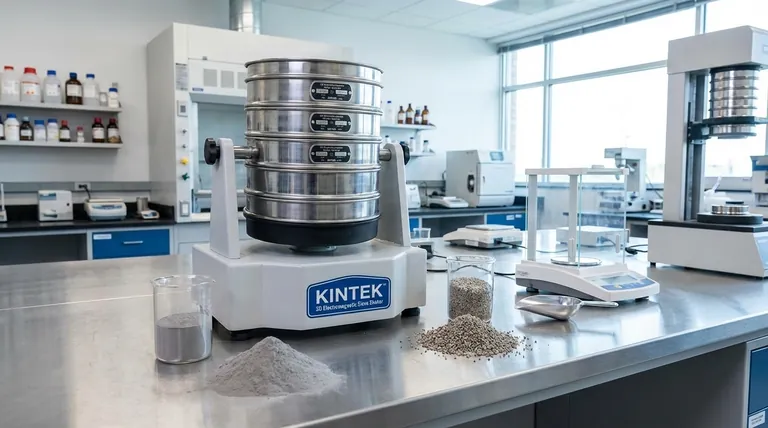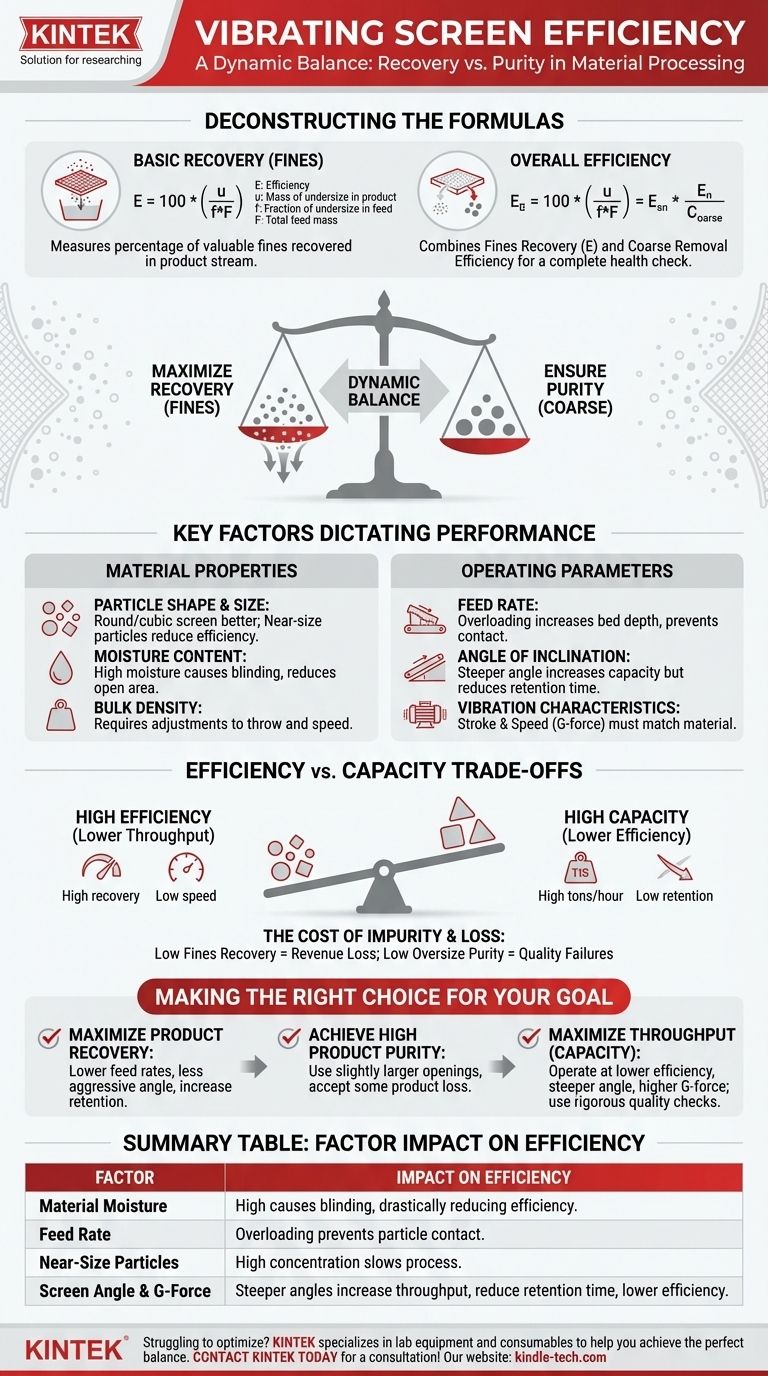In material processing, screening efficiency is the single most important measure of a vibrating screen's performance. It quantifies how successfully the screen separates the desired smaller particles (undersize) from the larger particles (oversize). In its simplest form, efficiency is calculated by dividing the mass of undersize material that correctly passed through the screen opening by the total mass of undersize material that was fed to the screen.
True screening efficiency is not a single number, but a dynamic balance between two competing goals: maximizing the recovery of valuable fine material and ensuring the purity of the coarse material. Understanding the factors that influence this balance is more critical than the calculation itself.

Deconstructing Screening Efficiency: The Core Formulas
To properly assess performance, you must understand how efficiency is calculated. While a simple formula provides a quick check, a more comprehensive approach gives the full picture.
The Basic Recovery Formula
The most common method measures the recovery of the undersize (fines). It answers the question: "Of all the fine material we fed the screen, what percentage actually made it to the product stream?"
The formula is: E = 100 * (u / f*F)
- E is the efficiency percentage.
- u is the mass of undersize material in the product that passed through the screen.
- f is the fraction of undersize material in the original feed.
- F is the total mass of the feed.
This formula is excellent for gauging how much valuable product you are recovering, but it doesn't tell you anything about the quality of your oversize material.
Introducing Overall Efficiency
A more robust calculation, often called overall efficiency, accounts for the misplacement of both fine and coarse particles. It combines the recovery of fines with the successful removal of coarse particles from the final product.
It is the product of two separate efficiencies:
- Efficiency of Fines Recovery: The formula described above.
- Efficiency of Coarse Removal: Measures how well the screen kept oversize particles from passing through.
100 * (mass of coarse in the oversize stream / total mass of coarse in the feed stream).
The combined Overall Efficiency provides a complete health check on your separation process, reflecting both product recovery and purity.
Key Factors That Dictate Screening Performance
Your efficiency percentage is not a fixed attribute of the machine; it is a direct result of material characteristics and operational parameters. Mastering these factors is the key to improving performance.
Material Properties
The physical nature of the material being screened is the most significant variable.
- Particle Shape and Size Distribution: Round, cubic particles screen far more easily than elongated, flat, or flaky ones. A high concentration of "near-size" particles—those just slightly smaller or larger than the screen openings—will dramatically lower efficiency by blinding or pegging the screen mesh.
- Moisture Content: This is a critical factor. High moisture causes fine particles to stick to larger ones and to the screen surface itself, a phenomenon known as blinding. This effectively reduces the open area of the screen and cripples efficiency.
- Bulk Density: Heavier materials behave differently on the screen deck than lighter ones, requiring adjustments to the machine's throw and speed to maintain proper material stratification.
Screen Operating Parameters
How you run the machine directly impacts the outcome.
- Feed Rate: Overloading the screen is the most common cause of poor efficiency. When the bed depth of material is too thick, particles in the upper layers never get a chance to contact the screen surface and pass through.
- Angle of Inclination: A steeper screen angle increases the speed at which material travels over the deck. This raises capacity (tons per hour) but reduces retention time, giving particles less opportunity to find an opening and thereby lowering efficiency.
- Vibration Characteristics: The combination of stroke (amplitude) and speed (frequency) generates the G-force that throws material up and forward. Higher G-forces are needed for fine, sticky materials, while lower G-forces are suitable for coarse, heavy separations.
Understanding the Trade-offs: Efficiency vs. Capacity
Optimizing a screening operation is rarely about achieving 100% efficiency. It is about finding the most profitable balance between competing operational goals.
The Inherent Conflict
There is a fundamental and unavoidable trade-off between screening efficiency and capacity (throughput). Pushing more tons per hour across the screen will almost always lead to a lower efficiency score because retention time is reduced and bed depth increases.
The Cost of Impurity vs. The Cost of Loss
Low efficiency has two distinct financial consequences:
- Low Fines Recovery: Valuable undersize product is carried over into the oversize waste stream, representing a direct loss of revenue.
- Low Oversize Purity: Undersize product contaminates the oversize stream. If the oversize is a final product, this can lead to quality control failures, customer rejection, and penalties.
The Challenge of Near-Size Particles
The battle for efficiency is won or lost based on how the screen handles near-size particles. These particles tend to get stuck in the openings (pegging) or take a very long time to orient themselves to pass through. A high percentage of near-size material requires you to sacrifice capacity for the retention time needed to achieve an effective separation.
Making the Right Choice for Your Goal
Improving efficiency begins with defining your primary objective. Your operational strategy must align with your most critical product requirement.
- If your primary focus is maximizing product recovery: Prioritize lower feed rates and a less aggressive screen angle to increase retention time, ensuring every valuable particle has a chance to pass through.
- If your primary focus is achieving high product purity (a clean oversize stream): You may need to accept some product loss by using a slightly larger screen opening to ensure all fines are effectively removed.
- If your primary focus is maximizing throughput (capacity): Be prepared to operate at a lower efficiency; use a steeper screen angle and higher G-force, but implement rigorous quality checks to ensure your product remains within specification.
Ultimately, viewing screening efficiency not as a static grade but as a dynamic outcome of adjustable factors is the key to mastering your process.
Summary Table:
| Factor | Impact on Screening Efficiency |
|---|---|
| Material Moisture | High moisture causes blinding, drastically reducing efficiency. |
| Feed Rate | Overloading increases bed depth, preventing particle contact with the screen. |
| Near-Size Particles | A high concentration slows the process, requiring a trade-off with capacity. |
| Screen Angle & G-Force | Steeper angles increase throughput but reduce retention time, lowering efficiency. |
Struggling to optimize your screening process? KINTEK specializes in lab equipment and consumables, providing the right solutions to help you achieve the perfect balance between screening efficiency, product purity, and throughput for your specific materials. Let our experts help you maximize your recovery and minimize loss. Contact KINTEK today for a personalized consultation!
Visual Guide

Related Products
- Three-dimensional electromagnetic sieving instrument
- Laboratory Test Sieves and Vibratory Sieve Shaker Machine
- Laboratory Vibratory Sieve Shaker Machine Slap Vibrating Sieve
- Laboratory Vibratory Sieve Shaker Machine for Dry and Wet Three-Dimensional Sieving
- Laboratory Wet Three-Dimensional Vibratory Sieve Shaker Machine
People Also Ask
- What are the components of a sieving machine? Unlock the Anatomy of Precision Particle Separation
- What is the principle of sieving machine? Achieve Accurate Particle Size Separation
- What are the disadvantages of sieve machine? Key Limitations in Particle Size Analysis
- What does a vibrating sieve do? Automate Particle Size Analysis for Accurate Results
- What is the operating procedure of a sieve shaker? Master Accurate Particle Size Analysis



















